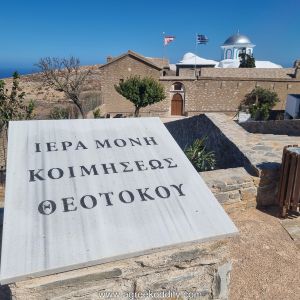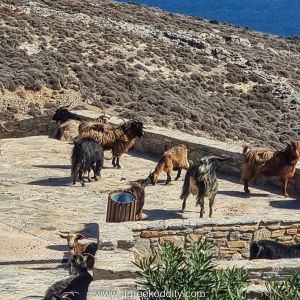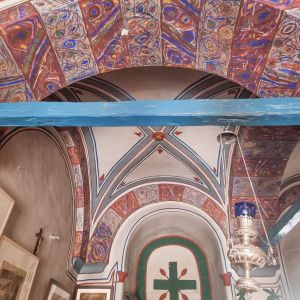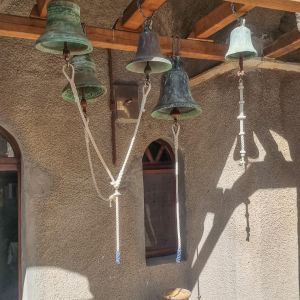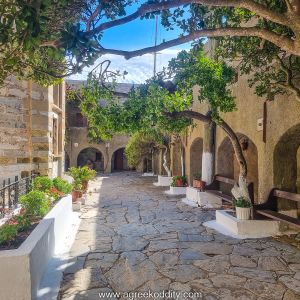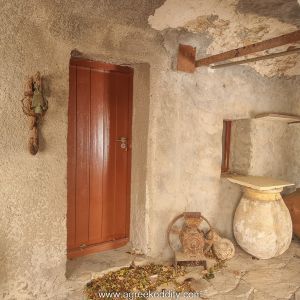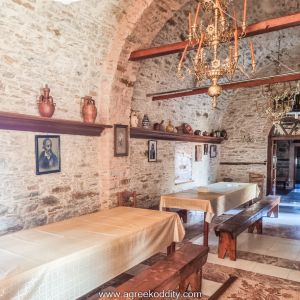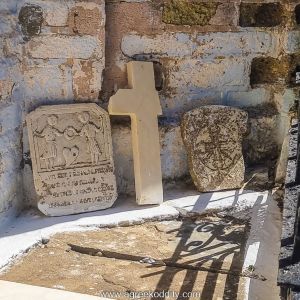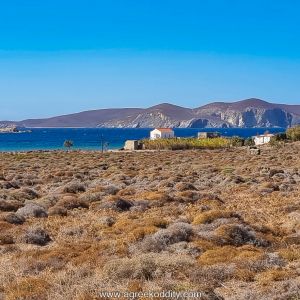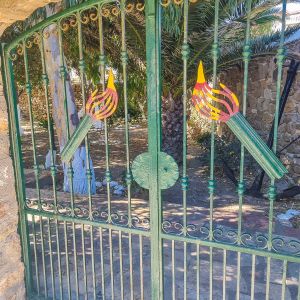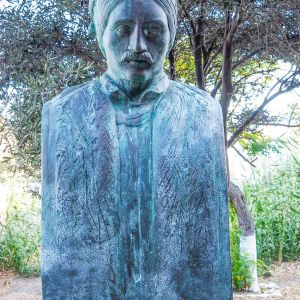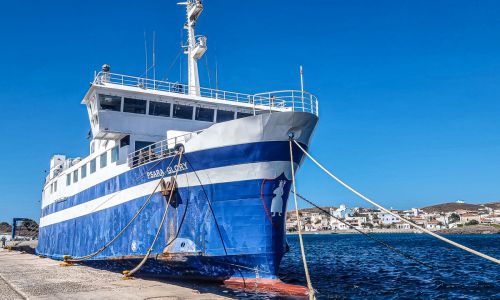Psara – The Monastery of the Assumption of the Virgin Mary
I’m so thrilled that my host Diana has been able to organise some trips for me. Google Translate has given it’s own interpretation on things and seems to indicate that I will be taken to the Monastery and Archaeological Park by a child.
Said ‘child’ messaged me to say that he would meet me at the Cafe Tsari on the harbour front at 11am on Sunday for the monastery trip. I got there early and ordered a cup of tea, telling the cafe owner that I was waiting for George. I know that there’s probably a lot of George’s on Psara but a hundred percent he’ll know which George I mean.
Soon after a motorbike pulled up. Gosh I hadn’t thought about that. What if this is the child and I’ll be heading over the hills on some bloke’s chopper! Phew – it isn’t him. Besides if it is a child then maybe he’ll be giving me a croggy on the back of his bicycle.
Right on time a four by four arrives and the man from the café indicates to me that this is George. I’ve now established that George is indeed a full grown adult – Google Translate fails again! After introductions are done I jump into his car and off we go. We fall into conversation really easily. George says that his English isn’t good but it certainly is good enough to communicate about a whole range of things. He asks me what I think about Psara and what have I seen so far. I tell him that I’d climbed Mavri Rachi the evening before and the view from the top is just stunning.
He tells me that every year there is a remembrance of the massacre to honour the people that had fallen. He also told me that when it rains you can sometimes see human bones being washed down the steps from the mountain of Mavri Rachi. Wow that does put it into perspective! This isn’t one of those stories from mythology. This actually happened in a not to distant history.
As we head out into the landscape I spot my first cluster of beehives. I mention to George that I was interested in getting some of the local honey as I had heard that it was the best. He told me that the thyme honey is very unique on Psara. It has a percentage of thyme much higher than other thyme honey. (at least that’s what I gathered). He told me that the production of this honey is very small and it is never enough to export off the island. The small amount that is made is kept on the island for either family use and also sold in the local shops. This year has been quite a poor production year. He tells me that one of his cousins has bees on the island and he will ask if he has some that I can buy from him. That’s amazing!
Before we reach the monastery we stop at the beach of Ftelio. George tells me that this was the scene of one of the most important and bloody battles that took place on Psara leading up to the island’s destruction.
The synopsis of this story is that Psara had donated it’s whole fleet along with Spetses and Hydra to form the three island fleet. This powerful force carried out a series of successful attacks on the Ottoman navy. George then tells me that the Sultan asked – ‘Where is this place called Psara?’ The Sultan looked on a map and and saw this tiny island off the coast of Chios. The Sultan was enraged at the people from an island so small that he could scratch them off the map with his fingernail. (I like the way George tells the story rather than how it’s written on the stone!). This was the beginning of the fateful revenge on Psara. The island knew that it would soon be under attack and was on standby at all accessible points around the island. On the East coast of the island, at the bay of Erios, there was an access point guarded by just 18 people. From the bay there was a steep cliff to climb at Cape Merkaki. It was thought unlikely that the Ottomans would make it. However, they were wrong and the Ottomans climbed the cape giving them a gateway onto the island. The 18 put up a good fight but were slaughtered.
Fteltio Beach was the main access point into the village and all the troops re-grouped to Ftelio Beach to protect the islanders. As we know, this event ended in tragedy. Living my their motto of Freedom or Death, the gunpowder store was ignited, blowing up most of the residents of Psara along with the Ottoman enemy. Only 3000 people out of a population of around 20,000 managed to escape.
Looking out over Ftelio Beach it is hard to imagine what took place here. Now one of the islands best beaches for tourism, it seems so far removed from what took place in a relatively recent history.
Back in the car, we soon arrive at the monastery. The Monastery of the Assumption of Mary is located as far North as you can get on Psara. Here you can feel the full force of the wind as it is open to the elements and away from the protection of surrounding islands. The monastery is no longer serviced by monks or nuns. George tells me that it is maintained and operated by volunteers from the local community.
The first thing that we see is a cluster of goats within the monastery complex. Occasionally the goats are slaughtered and sold to the locals and with all proceeds going back to the church.
There is no record of when the monastery was built. However, an English traveller records that in 1740, there was a small church there where 3 monks lived. The estimated date of construction is around 1780.
During the destruction of Psara in 1824, all the monks except one was massacred. George points out a bullet hole in one of the columns to me. Monks did return to the island and numbered about 50 in 1830. However, in 1880, the monastery was converted into a nun convent. George says that he can remember the abbess as an old lady from when he was a small boy.
After walking around the courtyard we enter the chapel. I’m mindful of the religious significance of this place as George crosses himself and lights a candle. I don’t take photographs in here. George points out an icon of the virgin Mary. He tells me that the original of the icon is in Syros where it was secretly taken off the island to protect it from the Ottomans. This icon is taken out during certain festivals and is much revered by the islanders.
Next we head into the refectory where George introduces me to man who is one of the volunteers here. I hadn’t realised until now that the monastery had been opened up just for us! The refectory and kitchen is used during religious festivals where traditional pistachio soup is made. The rooms that used to be the living quarters for the monks and nuns is now accommodation for people to stay as a spiritual retreat. Even I as an atheist can see that this place of tranquillity can be good for the soul.
What a great visit that was. We head back through the barren landscape where we get a clear view of the little island of Antipsara and its amazing beach. I mention to George that the little cuboid churches look modern but he say that are very old but they have been renovated.
On the way back I ask George about Psara Museum and asked when it would be open. He tells me that the museum will not be open as all of the artifacts were sent to Chios where they will be looked after better. The museum is a simple building and doesn’t have all of the climatatic controls etc needed to preserve the artifacts.
I also ask him about the house of Konstantine Kanaris, the island’s hero. Apparently this house no longer exists but there is a garden which acts as a memorial to him – George will take me there when we get back to the village. As we get close to the intersection George tells me that he is going to take me a slightly different way into the village – and Woooah! I can see why. Just looks at this view from the approach to the village! It’s amazing! Mavri Rachi on the left and St Nikolaos Church on the other mount with the maze of the village inbetween. The port is to to the left of Mavri Rachi.
Just a little bit further along we pass the army base (thankfully out of shot here). George says that they soldiers do 20 day stints before moving onto the next place. He says being based here on Psara is easy – he knows as he did his own service on the island. The day consists of a little military exercise and the rest is free time. I’m sure there are worse places.
Once back into the village we stop at at metal gate which is the entrance to what remains of the house of Konstantinos Kanaris. The house is just a few perimeter stones but the garden is well tended – a respectful resting place for his memorial.
George drops me back by the port and we arrange to meet at 10am the following day for a trip to the Archaeological Park. He will let me know what his cousin says about the honey!
Because it’s Sunday the Psara Glory is in port – a bit of a rest day for her and the crew. I think back to when I first arrived on Chios for just one night before heading off to Oinousses – I’d seen both the Psara Glory and the Oinoussai iii moored up side by side. I remember thinking what an odd looking ship she was. I’d looked on the Marine Traffic app to get some more information on her and discovered that she was built in Denmark in 1980 making her 42 years of age. That’s quite old for a passenger ship. However, now I know a little bit more about her namesake and the history of her home island, I have a newfound respect for her.
Later that afternoon I get a text message from George asking me if I’d like 1 kilo or 2 kilo’s of honey! Excellent! After I try and fathom out how big (or rather how heavy) a kilo of honey is I settle for just 1 kilo as it will have to be lugged around with me for the rest of my stay. At last I’m beginning to feel a bit more connected – and that makes all the difference to the experience.
Roll on tomorrow and my trip to the Archaeological Park.!


